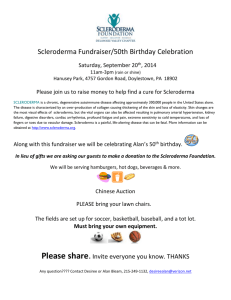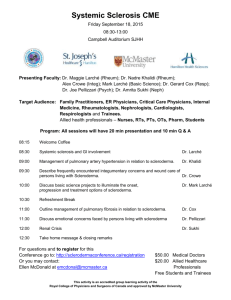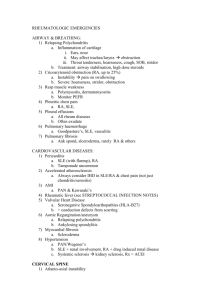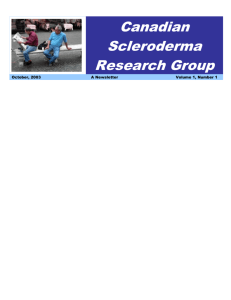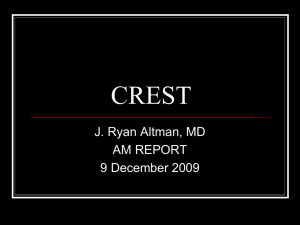CONNECTIVE TISSUE DISEASE
advertisement
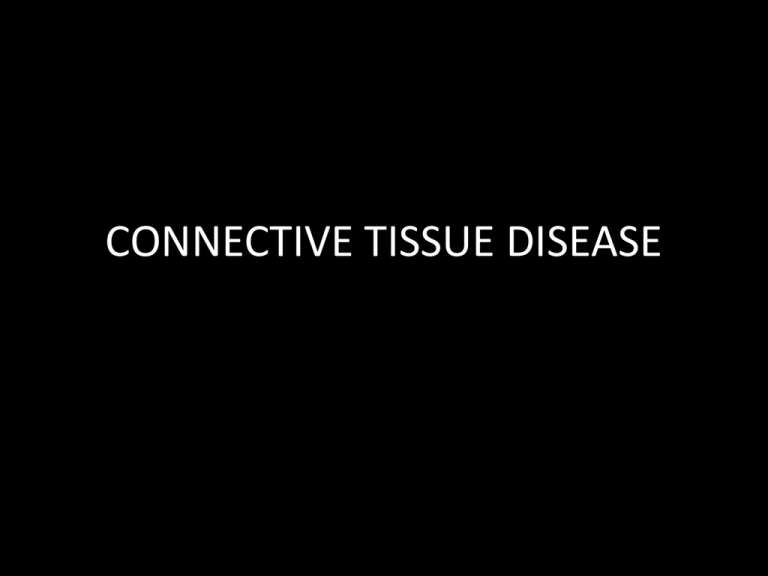
CONNECTIVE TISSUE DISEASE SLE • Joint space narrowing is uncommon in systemic lupus erythematosus A. TRUE B. FALSE ANSWER • Joint space narrowing is uncommon in systemic lupus erythematosus A. TRUE B. FALSE - Joint space narrowing is uncommon, and when present is likely due to disuse atrophy or pressure from an adjacent subluxed bone. Altered stresses across the joint may also cause a "hook erosion" at the metacarpal heads due to capsular stress, mimicing findings of rheumatoid arthritis. This is more often observed on the radial side. • Patients with SLE are at increased risk for insufficiency fractures, possibly due to : A. B. C. D. Disuse demineratization Osteopenia secondary to steroid therapy Normal or abnormal forces on weakened bone All of the above ANSWER • Patients with SLE are at increased risk for insufficiency fractures, possibly due to : A. B. C. D. Disuse demineratization Osteopenia secondary to steroid therapy Normal or abnormal forces on weakened bone All of the above • Distribution of radiographic abnormalities in the hand of patients with lupus arthropathy A. MCP and PIP joints of all digits B. MCP and IP joints of the ulnar digits, particularly the 4th and 5th fingers C. MCP and IP joints of all the digits; prominent abnormalities of the thumb D. All of the above ANSWER • Distribution of radiographic abnormalities in the hand of patients with lupus arthropathy A. MCP and PIP joints of all digits (RHEUMATOID ARTHRITIS) B. MCP and IP joints of the ulnar digits, particularly the 4th and 5th fingers (CLASSIC JACCOUD’S ARTHROPATHY) C. MCP and IP joints of all the digits; prominent abnormalities of the thumb D. All of the above CASE 1: • 27 year old female with SLE, on steroid therapy • (+) left hip pain ANSWER: AVASCULAR NECROSIS OF THE FEMORAL HEAD • • • • • Osteonecrosis or AVN occurs in 5%– 50% of SLE patients Mainly affects weight-bearing The femoral head is most commonly affected, followed by the humeral head, femoral condyle, and tibial plateau Radiographs are usually normal in early AVN, and late changes of bone sclerosis indicate the presence of irreversible articular damage With radiography, a grading system is used to denote the severity of AVN according to the sclerosis, flattening of the articular surface, and joint space abnormalities – stage 0 (clinically suspected AVN) to stage V (obvious joint space narrowing and articular surface disruption) CASE 2 • Same patient • (+) ankle pain • No history of trauma ANSWER: INSUFFICIENCY FRACTURE DISTAL FIBULAR DIAPHYSIS • • • • Normal stress on abnormal bone can cause insufficiency fractures In patients with SLE, the pathogenesis of insufficiency fractures is unclear but may be related to deconditioning, accelerated bone loss due to steroid therapy, or both MR imaging may depict early or subtle insufficiency fractures, which may be occult on radiographs due to severe osteoporosis At T2-weighted MR imaging, insufficiency fractures appear as areas of high signal intensity due to bone marrow edema in characteristic stress locations CASE 3 • SLE patient • Leg pain • (+) fever ANSWER: OSTEOMYELITIS • Dermatologic factors, corticosteroids, and vasculopathy predispose patients with SLE to septic arthritis and osteomyelitis • Because of steroid therapy, infection can be masked, and chronic indolent disease is often seen • Organisms: S aureus, gramnegative bacilli, and M tuberculosis • Radiographic : progressive bone destruction and cartilage loss, periostitis, and joint effusion CASE 4 ANSWER: MULTIPLE BONE INFARCTS Anteroposterior radiograph of the left knee shows sclerosis in the distal femur and proximal tibia. Sagittal T1-weighted MR image shows foci of isointense signal encircled by a low-signalintensity rim in the distal femur and proximal tibia (arrows). The hypointense rim represents reparative granulation tissue surrounding infarcted bone. SCLERODERMA Patient with scleroderma. ANSWER: ACRO-OSTEOLYSIS • Refers to terminal tuft bony erosions. It is associated with a heterogeneous group of pathological entities – primary acroosteolysis - Hajdu-Cheney syndrome – psoriatic arthritis – hyperparathyroidism – polyvinyl chloride exposure – insensitivity to pain – ergot poisoning – thermal injury – extreme cold : frost bite – extreme heat : burns – leprosy – juvenile chronic arthritis (JCA/JIA) – dermatomyositis – vascular occlusion – Raynaud disease – Scleroderma • Alterations at the distal IP joints are usually confined to regional or periarticular osteoporosis and swelling and thickening of the adjacent soft tissue, without evidence of joint space narrowing or osseous erosions • However, joint manifestations in scleroderma closely resemble those of RA, with osteoporosis, joint space narrowing and osseous erosions • In some patients with scleroderma, alterations occur at the DIP, articulations that are not commonly involved in RA. • Scleroderma-like syndrome with eosinophilia, hypergammaglobulinemia, but without systemic or vascular involvement A. B. C. D. SCLERODERMA ADULTORUM SHULMAN’S SYNDROME THIBIERGE-WISSENBACH SYNDROME CREST SYNDROME ANSWER • Scleroderma-like syndrome with eosinophilia, hypergammaglobulinemia, but without systemic or vascular involvement A. SCLERODERMA ADULTORUM – benign, self limited condition unrelated to scleroderma that occurs after infection; characterized by non-pitting edema of the skin and spontaneous resolution within a few months B. SHULMAN’S SYNDROME C. THIBIERGE-WISSENBACH SYNDROME – combination of calcinosis and digital ischemia D. CREST SYNDROME – subcutaneous calcinosis, reynaud’s phenomenon, esophageal abnormalities, sclerodactyly, telangirctasia • Chemical that can induce cutaneous abnormalities simulating those of scleroderma A. B. C. D. VINYL CHLORIDE PENTAZOCINE BLEOMYCIN ALL OF THE ABOVE ANSWER • Chemical that can induce cutaneous abnormalities simulating those of scleroderma A. VINYL CHLORIDE B. PENTAZOCINE C. BLEOMYCIN D. ALL OF THE ABOVE – Other chemical agents: solvents, paraffin, silicone implants, coccaine, rapeseed oil • Relatively specific dental sign of scleroderma A. B. C. D. THICKENING OF PERIODONTAL MEMBRANE THICKENING OF ENAMEL AND DENTIN THICKENING OF DENTIN AND GINGIVA THICKENING OF GINGIVA AND ENAMEL ANSWER • Relatively specific dental sign of scleroderma A. B. C. D. THICKENING OF PERIODONTAL MEMBRANE THICKENING OF ENAMEL AND DENTIN THICKENING OF DENTIN AND GINGIVA THICKENING OF GINGIVA AND ENAMEL • Sites of osteolysis in scleroderma except A. B. C. D. PHALANGES OF THE HAND AND FOOT CARPAL BONES PROXIMAL POSTIONS OF RADIUS AND ULNA MANDIBLE ANSWER • Sites of osteolysis in scleroderma except A. PHALANGES OF THE HAND AND FOOT B. CARPAL BONES C. PROXIMAL POSTIONS OF RADIUS AND ULNA (DISTAL) D. MANDIBLE - OTHER SITES: RIBS, CLAVICLE, HUMERUS, ACROMION, CERVICAL SPINE RHEUMATIC FEVER • Patient with rheumatic fever • A deforming non erosive arthropathy characterised by ulnar deviation of the second to 5th fingers with MCP subluxation. • DIAGNOSIS? ANSWER: JACCOUD’S ARTHROPATHY • hand x rays typically shows marked ulnar subluxation and deviation at the MCP joints • absence of erosions is a notable feature, although occasionally hook erosions may be observed, which are similar to those seen in SLE and AS sevidence of muscle (soft tissue) atrophy also may be present • Diseases that may lead to deforming nonerosive arthropathy A. B. C. D. E. F. G. RHEUMATIC FEVER SLE RHEUMATOID ARTHRITIS AGAMMAGLOBULINEMIA A, B & C ALL OF THE ABOVE NONE OF THE ABOVE ANSWER • Diseases that may lead to deforming non-erosive arthropathy A. RHEUMATIC FEVER B. SLE C. RHEUMATOID ARTHRITIS D. AGAMMAGLOBULINEMIA E. A, B & C F. ALL OF THE ABOVE G. NONE OF THE ABOVE - ALSO EHLERS-DANLOS SYNDROME • CLINICAL MANIFESTATIONS NECESSARY FOR DIAGNOSIS OF JACCOUD’S ARTHROPATHY EXCEPT: A. HX OF RECURRENT ATTACKS OF ACUTE RHEUMATIC FEVER B. IMMEDIATE RECOVERY AFTER JOINT INFLAMMATION C. ELICITATION OF TENDON CREPITUS D. JOINT DISEASE THAT IS GENERAKKY ASYMPTOMATIC ANSWER • CLINICAL MANIFESTATIONS NECESSARY FOR DIAGNOSIS OF JACCOUD’S ARTHROPATHY EXCEPT: A. HX OF RECURRENT ATTACKS OF ACUTE RHEUMATIC FEVER B. IMMEDIATE RECOVERY AFTER JOINT INFLAMMATION (DELAYED RECOVERY; WITH SUBSEQUENT DEFORMITY OF THE MCP JOINT) C. ELICITATION OF TENDON CREPITUS D. JOINT DISEASE THAT IS GENERAKKY ASYMPTOMATIC - ALSO: CHARACTERISTIC ARTICULAR DEFORMITY CONSISTING OF FLEXION AND ULNAR DEVIATION AT THE MCP, PARTICULARLY IN THE 4TH AND 5TH DIGITS
